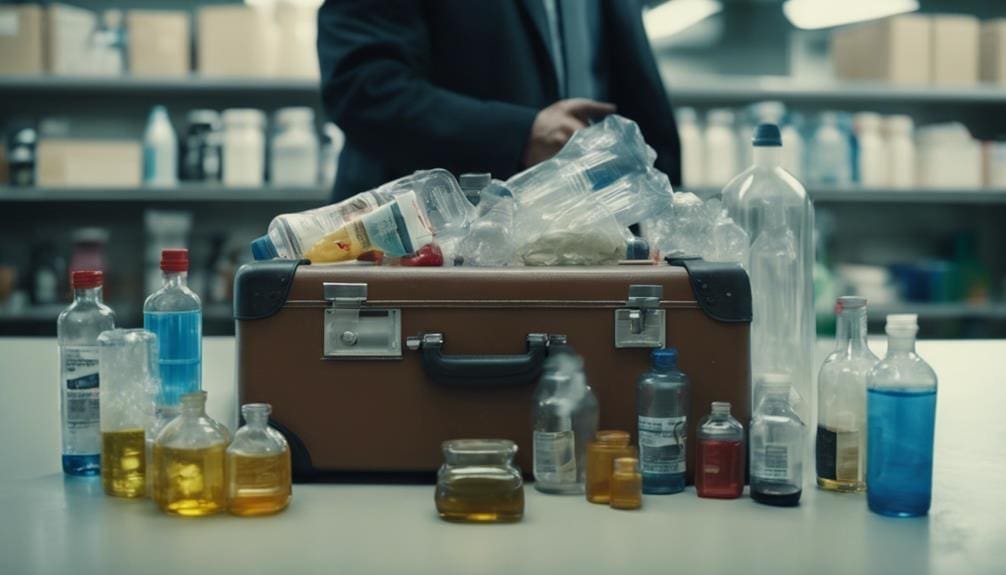When it comes to navigating liquid rules in checked baggage, the line between what’s permissible and what’s not can seem blurry. But fear not, by understanding a few key principles, you can breeze through this process with confidence.
Whether you’re a seasoned traveler or a newbie to airline regulations, knowing how to handle liquid items in your checked bags can save you from unexpected hassles and keep your journey stress-free.
Key Takeaways
- Full-size liquid bottles allowed in checked bags, excluding dangerous substances.
- Duty-free liquids from international purchases can be in checked baggage.
- Securely pack liquids using duct tape, zipper bags, and bubble wrap.
- Consider professional packing options like styrofoam shippers for liquid safety.
Understanding Airline Regulations for Liquids
When traveling by air, navigating liquid rules is essential to make sure compliance with safety measures and avoid any potential issues with your checked baggage. According to TSA guidelines, full-size bottles of liquids are permitted in checked bags. However, it’s important to keep in mind that certain dangerous liquids like flammable substances are strictly prohibited in both checked and carry-on luggage. Liquids such as alcoholic beverages with an ABV over 70%, toxic substances, and other specific items are also not allowed in luggage due to safety concerns.
Before packing your liquids in checked baggage, it’s advisable to take into account any destination-specific regulations that may apply. Additionally, duty-free liquids purchased after passing through security in U.S. airports may be permitted in the cabin or stored separately during the flight. By following these regulations and being mindful of the restrictions on liquids, you can ensure a smooth and hassle-free travel experience without any issues related to your checked baggage.
Exemptions and Restrictions for Checked Liquids
Managing exemptions and restrictions for liquids in your checked baggage guarantees compliance with airline regulations and contributes to a hassle-free travel experience. When it comes to liquids in checked baggage, there are specific exemptions and restrictions you need to be aware of.
Duty-free liquids purchased internationally can be carried in checked baggage even if not in a secure bag. Similarly, liquids over 3.4 oz that aren’t in a secure bag must also be packed in checked luggage. However, certain items like medications, infant formula, and special dietary needs are exempt from the liquid rule in checked baggage, providing some flexibility for essential items.
Duty-free liquids bought after security in U.S. airports are also permitted in checked luggage. It’s important to remember that certain dangerous liquids, such as flammable substances, are prohibited in both carry-on and checked baggage for safety reasons.
Understanding these exemptions and restrictions will help make certain a smooth and stress-free journey.
DIY Tips for Securing Packed Liquids
For added security when packing liquids in your checked baggage, consider using duct tape to secure the bottle tops. Here are some DIY tips to help you secure your liquid items effectively:
- Place the items in a zipper-top plastic bag for an added layer of protection.
- Seal the plastic bag and then put it inside a larger zipper-top bag for further security.
- Add bubble wrap around breakable liquid items to prevent damage during transit.
- Position the packed liquids in the middle of the suitcase surrounded by soft items for cushioning.
Professional Strategies for Liquid Safety
To enhance the security of liquids in your checked baggage, consider incorporating professional strategies that prioritize safety and protection during transit.
When packing liquids, using styrofoam or bubble wrap shippers can provide added protection. Brands like VinniBag or Wine Mummy offer specialized options tailored for safely transporting liquids, ensuring they reach their destination intact.
Explore boxes designed specifically for glass and liquid transport to guarantee secure packing, minimizing the risk of breakage.
When deciding between bubble wrap bags and box shippers, compare the benefits each offers regarding space and protection to choose the most suitable packing method for safeguarding your liquids during travel based on your specific requirements.
Best Practices for Packing Liquid Items
When preparing liquid items for packing in checked baggage, make sure that the tops of the bottles are securely wrapped with duct tape and placed in a zipper-top plastic bag for added security during transit.
Here are some best practices to contemplate when packing liquid items:
- Double Protection: Seal the plastic bag containing the liquid items and then place it in a larger zipper-top bag for an extra layer of security in checked baggage.
- Bubble Wrap for Fragile Items: Use bubble wrap to protect breakable liquid items from damage, positioning them in the middle of the suitcase surrounded by soft items for cushioning.
- Professional Packing Options: Consider utilizing specialized packing options like styrofoam or bubble wrap shippers, VinniBag, or dedicated glass and liquid transport boxes for enhanced protection.
- Anticipate Inspections: Be prepared for potential baggage inspections by security screeners when packing liquids in checked baggage, ensuring compliance with regulations and facilitating a smoother travel experience.
Conclusion
So, now you’re a pro at navigating liquid rules in checked baggage.
Remember, follow the guidelines, secure your liquids like a pro, and you’ll breeze through airport security.
Who knew packing liquids could be so thrilling?
Happy travels!














